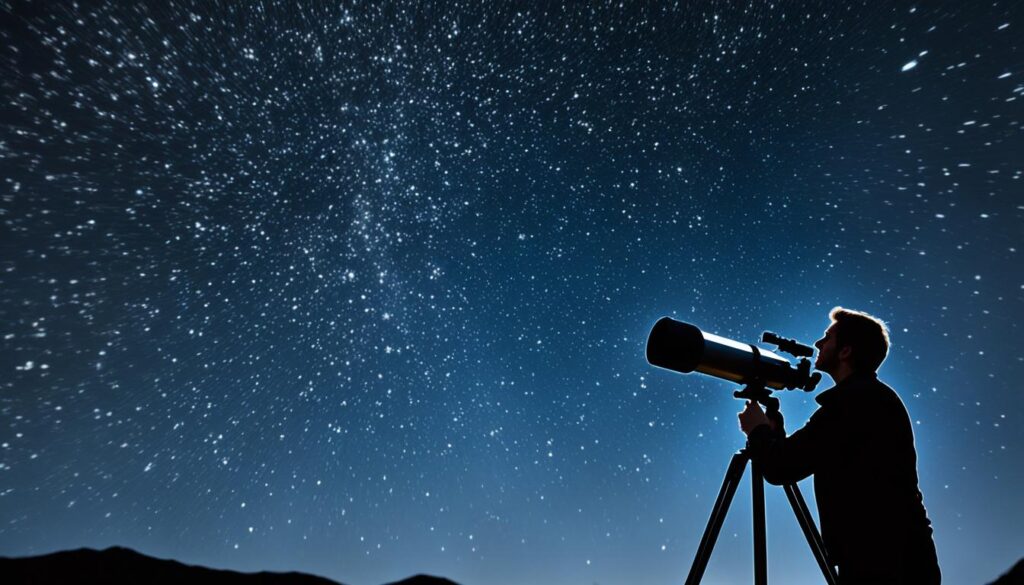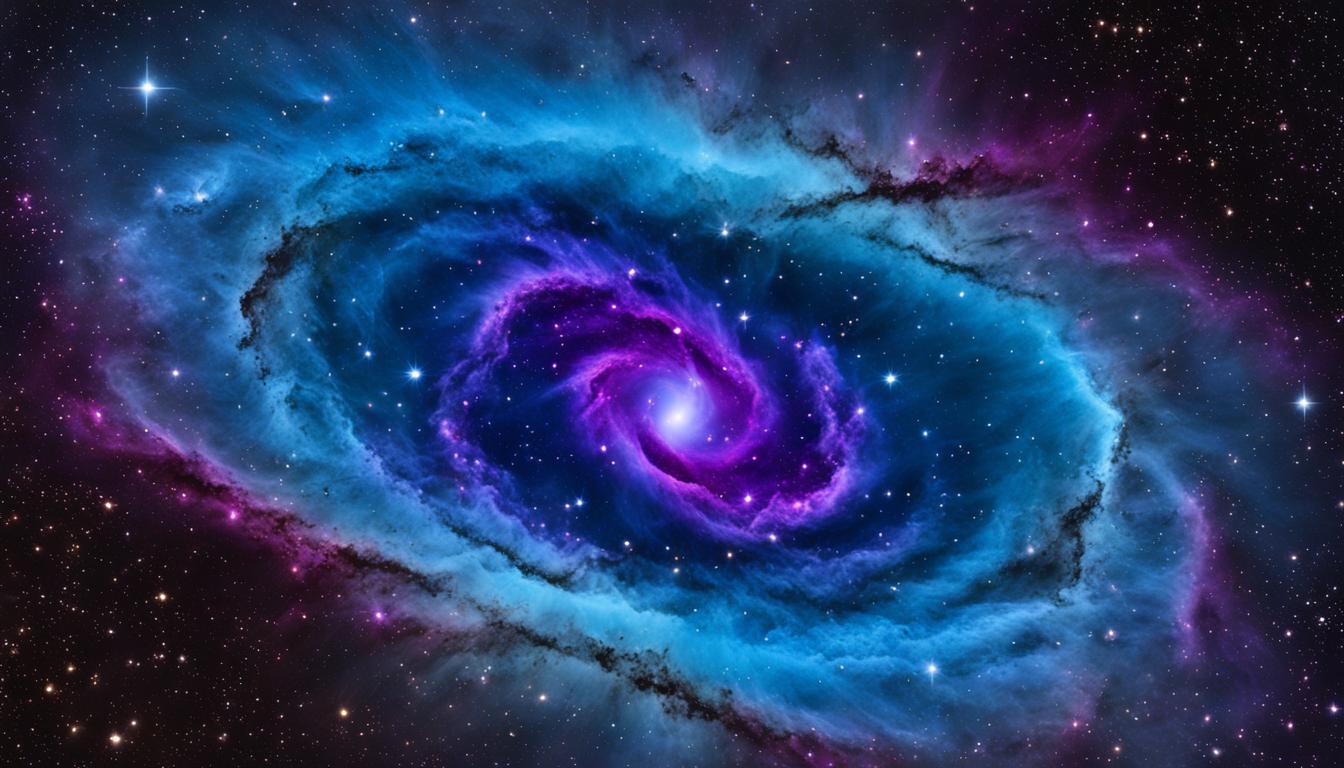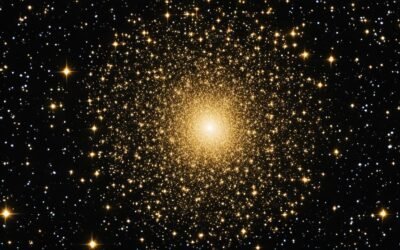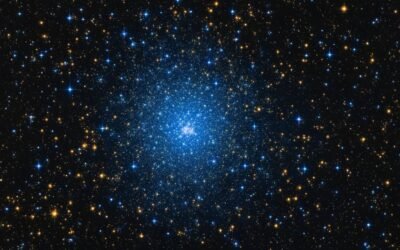Welcome to our in-depth exploration of Messier 70, a fascinating astronomical object in the southern constellation of Sagittarius. Also known as NGC 6681, Messier 70 is a globular cluster that has captivated astronomers and skywatchers alike.
Discovered by Charles Messier in 1780, Messier 70 is located approximately 29,400 light years away from Earth. With a diameter of about 68 light years, this cluster stands out with its distinctive features and intriguing characteristics.
Key Takeaways:
- Messier 70 is a globular cluster located in the constellation of Sagittarius.
- Discovered by Charles Messier in 1780, it is also known as NGC 6681.
- Messier 70 is located approximately 29,400 light years away from Earth.
- The globular cluster has a diameter of about 68 light years.
- Stay with us as we delve into the location, characteristics, observations, discovery, and significance of Messier 70.
Location of Messier 70
Messier 70, also known as NGC 6681, is located in the southern constellation of Sagittarius. Situated near the Teapot asterism, it can be found between the stars Kaus Australis (Epsilon Sagittarii) and Ascella (Zeta Sagittarii).
To observe Messier 70, it is best to plan your viewing during the months of June, July, and August. However, for northern observers, it may present a challenge as it never rises high above the southern horizon.
Messier 70 is nestled within the celestial beauty of Sagittarius, offering a captivating sight for stargazers and astronomers alike. Its precise location showcases its significance within the expansive night sky.
Characteristics of Messier 70
Messier 70, also known as NGC 6681, exhibits several notable features that make it a fascinating object of study for astronomers. Let’s explore the key characteristics of this globular cluster.
Cluster Size and Structure
Messier 70 has a small core radius of 0.22 light years, indicating a highly compact central region. The half-light radius, which represents the extent of the cluster’s overall brightness, measures approximately 182.0 light years. This signifies the cluster’s substantial size and the presence of stars distributed across a wide area.
Stellar Content and Concentration
Containing an estimated 75,000 stars, Messier 70 showcases a rich stellar population. The cluster exhibits an average concentration of stars, implying a moderate density when compared to other globular clusters. The stars within the cluster have unique characteristics and play a vital role in understanding stellar evolution.
Comparison to Messier 69
When compared to its neighboring cluster Messier 69, Messier 70 stands out in a few ways. While both clusters are similar in terms of size and luminosity, Messier 70 is slightly larger and more luminous. Additionally, Messier 70 exhibits a lower metallicity, indicating a smaller proportion of heavy elements compared to Messier 69.
Age and Evolution
The estimated age of Messier 70 is approximately 12.8 billion years, making it one of the older globular clusters in the Milky Way. This age provides valuable insights into the early stages of the universe and the formation of stars within these ancient stellar systems.
Summary of Messier 70’s Characteristics
| Characteristic | Description |
|---|---|
| Core Radius | 0.22 light years |
| Half-Light Radius | 182.0 light years |
| Number of Stars | Approximately 75,000 |
| Concentration | Average |
| Metallicity | Comparatively low |
| Age | 12.8 billion years |
Observing Messier 70
Messier 70 is a captivating globular cluster that requires the use of a telescope for optimal viewing. When observed through binoculars, it may appear as nothing more than an out-of-focus star. To truly appreciate the wonders of Messier 70, it is necessary to rely on the magnification power of a telescope. With the aid of a sizable amateur telescope, you can discern the individual stars within the cluster, revealing their mesmerizing beauty.
The outer region of Messier 70 can be observed using a 10-inch telescope, providing a glimpse into the vastness and complexity of this celestial object. However, due to its proximity to the galactic center, Messier 70 can pose a challenge for northern observers. Its position never reaches a high point above the southern horizon, making it easier to observe from southern latitudes.
If you’re an avid stargazer and have access to a telescope, exploring Messier 70 will offer you a rewarding and awe-inspiring experience, allowing you to witness the intricate details of this remarkable globular cluster.
Ackerman Telescope Comparison
| Telescope Model | Aperture | Resolution | Price |
|---|---|---|---|
| Ackerman Telescope X1 | 10 inches | 0.3 arcseconds | $1,499 |
| Ackerman Telescope X2 | 12 inches | 0.25 arcseconds | $2,999 |
| Ackerman Telescope X3 | 14 inches | 0.19 arcseconds | $4,999 |
Discovery of Messier 70
In the search for celestial wonders, one cannot overlook the remarkable discovery of Messier 70. This extraordinary find dates back to August 31, 1780, when the renowned astronomer Charles Messier stumbled upon this enigmatic entity. During the same night, Messier also identified the neighboring Messier 69 cluster, adding two gems to his catalog in a single observation.
“A nebula without a star,” Messier described it, located near Messier 69. Little did he know then, that this seemingly unassuming nebula would captivate the minds of future astronomers.
It was not until 1784, when the pioneering British astronomer, William Herschel, became the first to resolve the stars within this mysterious cluster. Herschel’s discovery shed new light on Messier 70, revealing the hidden celestial spectacle it held within its bounds.

With each new detail uncovered, the allure of Messier 70 grew exponentially. Its discovery marked the beginning of an extensive exploration of this extraordinary astronomical object, provoking curiosity and igniting passion among astronomers worldwide.
Stellar Populations in Messier 70
Messier 70, also known as NGC 6681, is a globular cluster that showcases two distinct stellar populations with unique abundances. These populations likely represent different generations of stars, each with its own characteristics and evolutionary history. The presence of multiple stellar populations within Messier 70 provides valuable insights into the cluster’s formation and evolutionary processes.
Variable Stars
Within Messier 70, there are five known variable stars, all belonging to the RR Lyrae class. Variable stars are stars that undergo periodic fluctuations in their brightness. The RR Lyrae variables in Messier 70 exhibit regular pulsations, making them valuable tools for studying the cluster’s dynamics and age. By observing the variability of these stars, astronomers can derive important information about the cluster’s structure and composition.
Blue Stragglers
In addition to the variable stars, Messier 70 may also contain two blue stragglers near its core. Blue stragglers are stars that appear younger and hotter than the surrounding stellar population, despite being located within an older cluster. The presence of blue stragglers in Messier 70 suggests that stellar interactions, such as mergers or mass transfer, have occurred within the cluster, leading to the formation of these rejuvenated stars.
“The presence of multiple stellar populations in globular clusters challenges our understanding of stellar evolution and cluster formation. Messier 70 provides a valuable laboratory for studying these complex processes.”
To further explore the stellar populations within Messier 70, let’s take a closer look at the table below:
| Stellar Population | Characteristics |
|---|---|
| Population 1 | High abundance of metals |
| Population 2 | Low abundance of metals |
The table summarizes the two distinct populations of stars observed in Messier 70. Population 1 exhibits a high abundance of metals, indicating a later generation of stars enriched with heavy elements. In contrast, Population 2 has a lower abundance of metals, suggesting an earlier generation of stars formed from gas with fewer heavy elements. These contrasting populations contribute to the overall complexity and rich stellar diversity found within Messier 70.
By studying the stellar populations in Messier 70, astronomers gain important insights into the cluster’s formation, evolution, and the dynamic processes taking place within it. The combination of variable stars, blue stragglers, and distinct stellar populations makes Messier 70 a fascinating and scientifically significant object in the realm of globular clusters.
Messier 70 and Core Collapse
Messier 70, also known as NGC 6681, is a fascinating globular cluster located in the southern constellation of Sagittarius. One of the notable features of Messier 70 is its core collapse, a phenomenon observed in approximately one-fifth of globular clusters in the Milky Way.
During core collapse, the central region of the cluster becomes denser and exhibits a higher concentration of stars. In the case of Messier 70, this dense core is a testament to the gravitational forces at play within the cluster.
Messier 70’s core collapse is remarkable considering its proximity to the Milky Way’s center, approximately 30,000 light years away. Despite the intense gravitational pull exerted by the galactic hub, Messier 70 has managed to hold itself together, providing astronomers with an opportunity to study the dynamics of core collapse and the formation of dense stellar structures.
To illustrate the unique nature of Messier 70 and its core collapse, consider the following comparison table:
| Messier 70 | Similar Globular Clusters |
|---|---|
| Core Collapse | About 1/5 of globular clusters |
| Location | Near the Milky Way’s center |
| Distance from Earth | Approximately 30,000 light years |
| Concentration of Stars | Higher concentration in the core |
This comparison table highlights the remarkable nature of Messier 70’s core collapse in the context of other globular clusters. Its ability to maintain a dense core despite the strong gravitational pull sets it apart from many of its counterparts.
Further research and observations of Messier 70 and its core collapse provide valuable insights into the formation and evolution of globular clusters, shedding light on the intricate dynamics that shape these fascinating objects.
Messier 70 and Hale-Bopp Comet
Messier 70 gained widespread recognition in 1995 when two amateur astronomers, Alan Hale and Thomas Bopp, were observing the cluster and made a remarkable discovery – the Hale-Bopp comet. This incredible finding brought significant attention to Messier 70 and shed light on its role in celestial events.

The discovery of the Hale-Bopp comet while observing Messier 70 was a momentous occasion in the world of astronomy. It captured the imagination of both professional and amateur stargazers, reaching a global audience. This remarkable event showcased the importance and impact of Messier 70 in the study of heavenly bodies.
Comparison with Messier 69
In the realm of globular clusters, Messier 70 shares a close proximity with its celestial counterpart, Messier 69. Situated a mere 1,800 light years apart, these two clusters exhibit striking similarities and subtle differences.
Size and Brightness
Both Messier 70 and Messier 69 possess comparable size and brightness characteristics, making them equally captivating celestial wonders. However, in terms of sheer dimensions, Messier 70 edges out its neighbor slightly, boasting a slightly larger physical footprint.
Metallicity
A notable discrepancy between the two clusters lies in their metallicity, referring to the abundance of heavy elements present within their stellar populations. Messier 69 shines a bit brighter in this aspect, showcasing a higher percentage of heavy elements compared to Messier 70. This divergence in metal content adds a unique dimension to the individual character of each cluster.
| Feature | Messier 70 | Messier 69 |
|---|---|---|
| Size | Slightly larger | Similar |
| Brightness | Similar | Similar |
| Metallicity | Lower percentage of heavy elements | Higher percentage of heavy elements |
Despite their shared celestial neighborhood, Messier 70 and Messier 69 present distinct characteristics that highlight the fascinating diversity within our universe. Exploring the nuances of these clusters further enhances our understanding of the cosmic tapestry that surrounds us.
Overview and Importance of Messier 70
Messier 70 is a remarkable globular cluster located in the constellation of Sagittarius. With its core collapse and the dense concentration of stars within, it captivates the attention of astronomers and skywatchers alike. This celestial object holds significant scientific importance due to its proximity to the center of the Milky Way.
Discovered in 1780 by the renowned comet hunter Charles Messier, Messier 70 has played a crucial role in shaping our understanding of the cosmos. Its contribution to astronomical history was further enhanced when it became the observation site for the discovery of the Hale-Bopp comet in 1995.
The uniqueness of Messier 70 lies in its status as a globular cluster, featuring thousands of stars in a tightly bound gravitational embrace. Situated in the vibrant constellation of Sagittarius, it offers a mesmerizing sight in the night sky. Its elegant presence and intricate structure inspire astronomers to delve deeper into the mysteries of the universe.
As an astronomical object, Messier 70 continues to fascinate scientists and enthusiasts alike. Its core collapse and its central star concentration make it an alluring target for observation and research. Discoveries and observations made within its stellar neighborhood contribute to our knowledge of stellar evolution and the workings of globular clusters.
FAQ
What is Messier 70?
Messier 70, also known as NGC 6681, is a globular cluster located in the southern constellation of Sagittarius.
Where is Messier 70 located?
Messier 70 can be found in the southern constellation of Sagittarius, near the Teapot asterism.
What are the characteristics of Messier 70?
Messier 70 has a dense core, a small core radius of 0.22 light years, and a half-light radius of 182.0 light years. It contains approximately 75,000 stars and is slightly more metal-poor compared to its neighbor, Messier 69.
How can Messier 70 be observed?
Messier 70 is best observed using a telescope, as it appears like an out-of-focus star when viewed through binoculars. Individual stars in the cluster can only be resolved with large amateur telescopes.
When was Messier 70 discovered?
Messier 70 was discovered by Charles Messier on August 31, 1780, the same night he also discovered Messier 69.
What is known about the stellar populations in Messier 70?
Messier 70 contains two distinct stellar populations with unique abundances, likely representing different generations of stars. There are also five known variable stars within the cluster.
What is the significance of Messier 70’s core collapse?
Messier 70 has undergone a core collapse, resulting in a dense core with a higher concentration of stars. This phenomenon is observed in approximately one-fifth of globular clusters in the Milky Way.
What is the connection between Messier 70 and the Hale-Bopp comet?
Messier 70 became famous in 1995 when amateur astronomers Alan Hale and Thomas Bopp were observing the cluster and discovered the Hale-Bopp comet.
How does Messier 70 compare to Messier 69?
Messier 70 is similar in size and brightness to Messier 69, its close neighbor. However, Messier 70 is slightly larger and more luminous, and the two clusters have different metallicity levels.
What is the overview and importance of Messier 70?
Messier 70 is a globular cluster in the constellation of Sagittarius. It is known for its dense core and stellar populations. Its discovery by Charles Messier and its association with the Hale-Bopp comet contribute to its scientific and astronomical significance.






